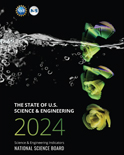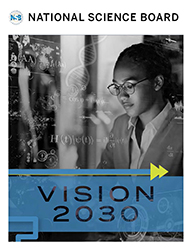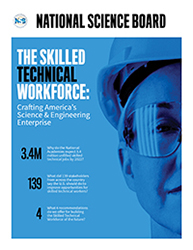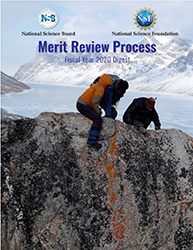
National Science Board Releases Report about Today’s Science and Engineering Labor Force
New Indicators report shows critical contribution of STEM workers to US economy
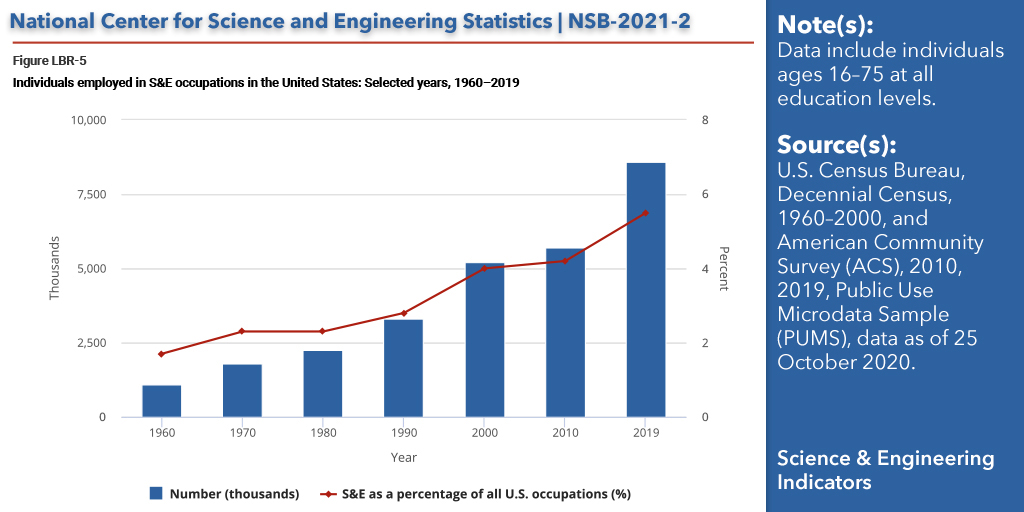
National Center for Science and Engineering Statistics (NCSES) (Credit and Larger Version)
September 1, 2021
The National Science Board (NSB) today released a new report, The STEM Labor Force of Today: Scientists, Engineers, and Skilled Technical Workers, which shows the critical contribution that STEM workers make to the U.S. economy and reinforces the value of training and education in science, technology, engineering, and math (STEM). The new report is part of the 2022 edition of the congressionally mandated Science and Engineering Indicators report on the state of the U.S. science and engineering enterprise.
In a shift from previous reports, the 2022 Labor Force report shows the full breadth of the STEM workforce by including the nearly 20 million individuals whose jobs require them to use significant levels of S&E expertise and technical knowledge but who do not hold a bachelor’s or higher degree.
“We see that many fields demand strong science skills, even if not all of them require advanced degrees,” said NSB member Suresh Garimella, lead reviewer of the report and President of the University of Vermont. “We must value the contributions that those in the skilled technical workforce make to our country. Science and technology are becoming a bigger and bigger part of modern life and we need a workforce that can help us navigate and thrive as the economy evolves.”
Including workers of all educational levels and the wide variety of occupations that require significant STEM knowledge and expertise, the NSB found that the STEM workforce represented 23 percent of the total U.S. workforce in 2019. A little over half of those working in STEM fields do not have a bachelor’s degree. These skilled technical workers are primarily in healthcare (19 percent), construction trades (20 percent), installation, maintenance, and repair (21 percent), and production occupations (14 percent).
The report also shows that STEM workers tend to have higher median earnings ($55,000) than non-STEM workers ($33,000) and the job market for those in STEM is more resilient than for those working outside of STEM fields. Unemployment among STEM workers was lower than the non-STEM labor force in 2019. This pattern persisted even during the COVID-19 pandemic.
“Given the job market resilience and higher income potential, it is troubling that the opportunities arising from STEM training and education are not equally distributed across all demographics and geographies,” said Garimella.
Although Blacks, Hispanics, and American Indians represent 30 percent of the employed U.S. population, they are only 23 percent of the STEM workforce due to underrepresentation among STEM workers with a bachelor’s degree or above.
“We need to urgently focus on building pathways into our STEM workforce for all parts of our population if the U.S. is to remain a strong player in the global economy. We also must ensure that no one is missing out on potential opportunities for great, well-paying, stable jobs,” said Garimella.
In its Vision 2030 report the NSB states that developing America’s STEM talent at all levels and addressing the ‘Missing Millions’ in STEM should be top priorities for the U.S.
About Science and Engineering Indicators
Science and Engineering Indicators (https://ncses.nsf.gov/indicators) is a congressionally mandated report on the state of the U.S. science and engineering enterprise.
About NCSES
The National Center for Science and Engineering Statistics (NCSES) is the nation's leading provider of statistical data on the U.S. science and engineering enterprise. As a principal federal statistical agency, NCSES serves as a clearinghouse for the collection, interpretation, analysis, and dissemination of objective science and engineering data.
About the NSB
The NSB identifies issues critical to NSF’s future, establishes its policies, and serves as co-head of agency with the NSF Director. The Board also advises the President and Congress on policy matters related to science and engineering (S&E) and S&E education. Selected for their distinguished service and accomplishments in academia, government, and the private sector, the Board’s 24 presidentially appointed members are leaders in science and engineering, and in science, technology, engineering, and math (STEM) education.
Useful NSB Web Sites:
Home Page: http://www.nsf.gov/nsb
Media Contact: http://www.nsf.gov/staff/staff_bio.jsp?lan=nlymn&org=NSF
News: http://www.nsf.gov/nsb/news
Meetings: http://www.nsf.gov/nsb/meetings
Publications: http://www.nsf.gov/nsb/publications
Facebook: https://www.facebook.com/NationalScienceBoard
Twitter: Twitter: https://twitter.com/intent/user?screen_name=NSF_NSB
YouTube: https://www.youtube.com/channel/UCkrHRzuGSrPp2haQs0T_Pww
To view PDF documents, please download Adobe Acrobat Reader.
